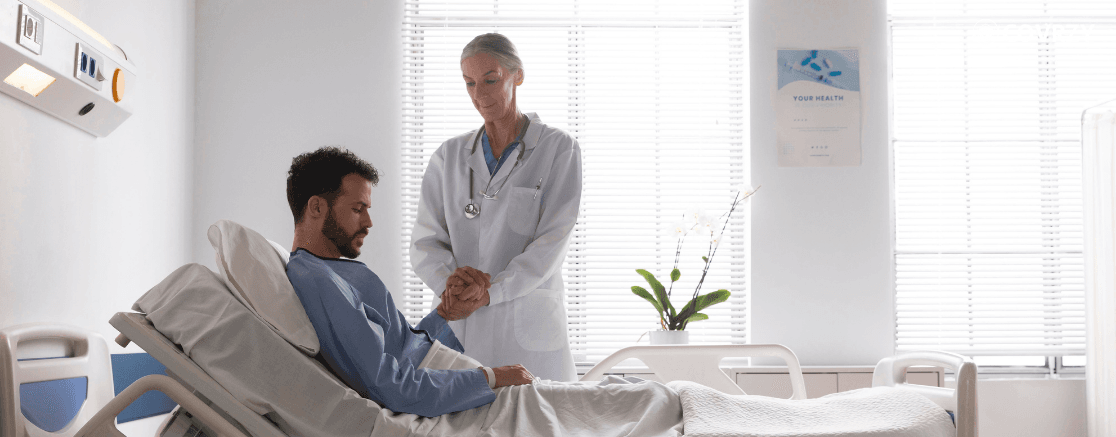Should You Have A Super Top Up Insurance or Critical Illness Rider?
Sourav Banik
Author

A few factors determine if a super top up health insurance or a critical illness rider will be suitable for you. For example, if you have a history of multiple hospitalisations, you should purchase a super top-up insurance. On the other hand, if you have any lifestyle-related disease and have a high risk of being diagnosed with a life-threatening disease, then buying a critical rider is the best option.
As India’s medical costs are rising by 12% - 14% on an annual basis, meeting hospitalisation costs has been a critical expense for the middle income earners. Having basic health insurance today is not sufficient. Most working professionals, especially in India, rely heavily on employer health coverage or government-aided policy. But these insurance policies will cover only the basic health failures. Serious healthcare fatalities will require you to choose a super top up healthcare policy, depending on your health condition.
Let’s understand if you should buy a critical health policy or a super top by breaking down their benefits and coverage details.
What Is Super Top-Up Health Insurance?

The best super top up health insurance provides coverage when the cumulative medical expenses exceed the base policy cover. While a top up insurance will only provide for expenses that exceed your single health claim, a super top covers various health claims.
For example, your employer has purchased a group health policy with a coverage limit of ₹5 lakh per employee. The super top-up for each policy is ₹3 lakh deductible. If your total hospital expenses in a year exceed ₹5 lakh and your base policy cannot cover it, your super top-up policy will pay for the additional ₹2 lakh.
Advantage of a Super Top Up Plan
What makes super top up health insurance different from a regular top-up plan is that it works on a cumulative claim basis, and not a claim basis. Super top-up is widely adopted among organizations because it covers the total annual medical expenses rather than individual medical expenses. Often, the total medical cost in a given year can still be a financial burden to an employee if his corporate health insurance is exhausted on one individual claim.
Also read how to manage your corporate health insurance premium after being laid off.
Example of a Super Top Up Insurance
Let’s understand how the best super top-up health insurance will work in real life. Anshul, a 28-year-old software engineer in Bengaluru, has an employer-provided base health cover of ₹5 lakh. His employer opts for a super top-up health insurance policy worth ₹8 lakh.
In January, Anshul suffers a major surgery, which costs him a total of ₹15 lakh. After 4 months, he is again diagnosed and undergoes a second surgery, which costs ₹3 lakh. The total medical expenses of these two surges add to ₹13 lakh.
While his base policy covers only a ₹5 lakh claim, the remaining cost of ₹8 lakh gets covered by his super top up insurance.
What Is a Critical Illness Rider?
A critical illness rider works quite differently. If your employer has opted for a critical illness rider on your base policy, you will receive a lump sum payout on being diagnosed with a fatal disease.
This will be irrespective of your hospitalisation, as a critical illness rider pays out as soon as the policyholder is insured with a life-threatening disease. The concept of a critical illness rider is to insure based on the diagnosis of a critical illness, irrespective of the hospitalisation costs.
Advantage of Critical Illness Rider
A critical illness rider functions on an add-on basis, and it can provide the benefit only when a policyholder consents to opt for it. The benefit of having a critical illness rider is that you will not have to be hospitalized to claim the benefits. You can claim it right after being diagnosed with a critical illness, as per the policy terms.
Some of the common illnesses that a critical illness rider covers are:
- Cancer (any stage or major)
- Heart attack or bypass surgery
- Kidney failure
- Stroke
- Alzheimer's Disease
- Organ transplant
- Multiple sclerosis
- Permanent paralysis
- Alzheimer’s disease
A critical illness plan covers most of the major disorders that a basic insurance plan will likely not cover. If you're self-employed or working in a physically demanding job, your base instance plan will not be sufficient. Opting for a critical illness cover will enhance your health protection to the maximum at a nominal premium.
Also read the top 20 employee management system apps that boost office productivity.
Example of a Critical Illness Cover
Palak works as an HR generalist in a Chennai-based firm, where her employer has provided her with a term life policy worth ₹4 lakh, with a critical illness rider worth ₹10 lakh. Palak suffers a sudden strike in the workplace and is hospitalized immediately. On being diagnosed with a stroke, Palak’s employer releases the ₹10 lakh lump sum to compensate for her treatment after an assessment of her condition. A critical disease cover thus releases a lump sum payout once the diagnosis report is submitted to the insurer.
Main Difference Between Super Top Up And Critical Illness Rider
By now, you may get confused between these two concepts. However, there are certain differences between a super top up and critical illness cover that change the objective and benefits.
Let’s take a look below:
| Factors | Super Top Up Health Insurance | Critical Illness Rider |
|---|---|---|
| Coverage Details | Covers cumulative medical expenses in a year when base policy is exhausted | Covers only critical illness on submission of diagnosis report |
| Cost of premium | Relatively Low | Relatively High |
| Preferred type of policyholder | Suitable for anyone who has a base sum insured of less than ₹5 Lakhs | Should be taken when you have a risk of critical illness due to lifestyle changes |
| Type of support | Release of claim benefit depends on total hospitalisation expenses exceeding base coverage | Release of claim benefit depends on diagnosis reports |
| Frequency of Claims | Can be claimed on annual basis | Can be claimed on diagnosis basis |
| Disadvantages | One of the disadvantages of super top-up health insurance is it does not cover venereal diseases, plastic surgery cost or HIV/AIDS cost | A disadvantage of critical rider is it covers only life threatening disease and excludes multiple disorders that may not be fatal. This amount may be deducted from your base sum insured. |
Also read top government business loan schemes for women in India.
Who Should Choose Super Top Up?

A super top-up health insurance is ideal in these cases:
- Your employer has already opted for a base policy, but it’s not sufficient
- You have a history of frequent hospitalisation
- Repeated hospitalisation costs are a financial strain for you
- You possess a family floater policy, including your spouse and parents
When you are looking to select the best super top up health insurance, you should also be aware of the premium payable. Usually, a super top up comes off with a much lower premium. This makes it a smart financial backup plan when repeated hospitalisations can financially challenge your sustainability in the long run.
Main Disadvantages of Super Top-Up Health Insurance
These major disadvantages are:
- Super top-up gets activated only when the cumulative hospitalisation expenses exceed the threshold of the deductible. Even if you get admitted due to a fatal condition, it may not get covered with a super top-up unless there are multiple such cases of hospitalisation.
- It comes with a waiting period for pre-existing diseases. If you get caught up with a major health disorder during the waiting period, you cannot claim the benefits of super top-up
- A super top-up plan does not cover cases such as rehabilitation or mental illness. Although this entirely depends on the insurance provider, it can vary.
At Covrzy, we always explain the coverage details before our users opt for a super top up.
Know the MSME 45-day payment rule, its terms, and its application in business.
Conclusion
If your main concern is to cover multiple hospitalisation expenses, then a super top up health insurance is an affordable option. But, if you are more worried about a serious health calamity and a possible loss of income disruption, then try to consider a critical illness rider as an option. While some corporate policies allow both super top up and a critical illness rider, you can also opt for these benefits if you port to an individual health plan. Whether you're salaried or self-employed, having secure financial coverage through insurance is a basic financial hygiene.
India’s CEOs are turning more to ensure their team members are more engaged these days. Our years of partnering with major Indian firms have shown us that the Indian work culture is evolving, and team wellness comes first for legacy and committed entrepreneurs. Covrzy brings employee wellness plans at affordable rates that fit your team as well as align with your business needs. Check out with our in-house advisors today. Reach out to [email protected], and we will respond within 1 hour!
Frequently Asked Questions
Explore moreWhat is the main difference between a critical illness plan and a rider?
A critical illness plan has a larger coverage than a critical illness rider, along with a base health insurance. Moreover, a critical illness covers all the expenses that a base insurance with a rider will not cover. A standalone plan is more flexible in terms of benefits and coverage than a rider with a health insurance policy.
What is the difference between a top up and a super top up?
The main difference between a top-up and a super top up insurance is that a super top-up works as an additional cover that covers multiple hospitalisation expenses when the base sum insured limit is exhausted while the top up covers only a single claim. You get more secure by choosing a super top up with a standalone wellness policy for your team.
What is the meaning of deductible in top-up insurance?
A deductible means the out-of-pocket expenses that you need to pay before your existing healthcare insurance starts. Deductibles depend on the policy and the terms of the insurer, and they vary generally across insurers.
Is there a waiting period in the top-up policy?
Yes, when you buy a top up policy, you will have to face a waiting period of a specific time. You cannot claim any coverage benefits during this waiting period, and must wait till this period expires.
What does OOP mean in hospitalization expenses?
OOP is the abbreviated form of out-of-pocket expenses in healthcare insurance. A policyholder needs to pay out of pocket in case of deductibles mentioned in their policy before their insurance policies start. Usually, these out-of-pocket expenses are not reimbursed by insurance policies.
Do you have more questions?
Contact us for any queries related to business insurance, coverages, plans and policies. Our insurance experts will assist you.
